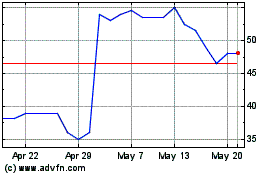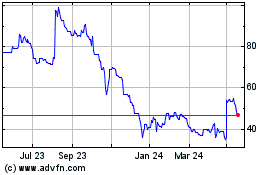TIDMBEH
RNS Number : 2318D
Bayfield Energy Holdings PLC
14 May 2012
14 May 2012
Bayfield Energy Holdings plc
("the Company")
Trinidad: Operational update
Bayfield Energy (Ticker Symbol: BEH), an independent oil and gas
exploration and production group with key assets in Trinidad &
Tobago and South Africa, provides an operational update on its
activities in Trinidad.
Well results from EG7
Well EG7 is drilling ahead, having reached 5,280ft and
encountered all the shallow reservoir objectives. In the interval
between 1,000ft and 3,000ft, the reservoirs identified as the F,G
and H Sands have been found to be predominantly water bearing. Only
one reservoir interval was logged as oil bearing and has been
sampled and tested with a mini drill stem test (mini-DST). The
reservoir intervals encountered had been evaluated to have been oil
bearing in the offset well EG1 (1964). Revised mapping, based on
results from EG7, now suggests, however, that crestal faults may
separate the EG1 oil bearing reservoirs from EG7.
Well data from EG7 will reduce the Contingent Resources volumes
assigned to the EG1 structure in the Company's Competent Person's
Report (the "CPR"), prepared by Gaffney, Cline & Associates
(May 2011). Management has assessed that the Company's net 2C
Contingent Resources of 24.67 mmbbl (37.96 mmbbl gross) will be
reduced by approximately 5.9 mmbbl (9 mmbbl gross).
In addition, the exploration objectives identified from the EG1
Prospect were classified as Prospective Resources in the CPR. The
shallowest of these was the "P Sand" section which has been proven
to be water bearing in EG7. Accordingly, management assesses that
it will no longer be appropriate to recognise the Unrisked
Prospective Resources associated with the "P sands" in the EG1
Prospect.
Following the detailed logging and sampling of the shallow
reservoirs, the well has been sidetracked and is drilling ahead to
the east to evaluate deeper exploration targets in a structurally
optimal position. These targets are located structurally higher
than the nearby well COS1 (1985), where sandstone reservoirs
exhibited oil shows while drilling but were not evaluated due to
mechanical problems. EG7 is planned to drill to a total depth of
6,500ft.
EG8 discovery
On 13 March, Bayfield reported that its exploration well, EG8,
had demonstrated development potential of 32 million barrels
(mmbbl) of oil and 69 billion standard cubic feet (bcf) of gas in
the EG2/EG5/EG8 Central and East fault blocks. Initial
interpretation suggested that substantially all of the gas
potential lies within the Galeota Licence though the oil potential
extends into an adjacent licence in which Bayfield has no
participating interest.
Subsequent to this announcement, Bayfield has signed a
memorandum of understanding ("MoU") with the operator of the
adjacent block, Repsol E&P T&T Limited ("Repsol"). The MoU
confirms the intention of Bayfield and Repsol to cooperate in
establishing a joint technical team to assess and allow for the
potential accelerated development of the accumulations of oil and
gas identified by EG8 and may ultimately lead to a reclassification
of Prospective and Contingent Resources.
Future rig deployment
Following the completion of EG7, the Gorilla III jack-up unit
will return to Niko to drill the second well of its programme and
is then expected to return to Bayfield later in the third quarter
of 2012 for the next planned two wells in its programme, EG9 and
GAL25, which are both structurally independent of EG7.
Bayfield has taken steps to provide greater operational and
financial flexibility concerning the timing of fulfilment of its
committed seven-well drilling programme. Firstly, it has agreed
amendments to the Galeota licence and Farm-out Agreement with
Petrotrin, to extend the period in which it was obligated to drill
the seven wells out to the end of March 2015. Secondly, it is close
to concluding negotiations concerning an assignment of the rig
contract which would allow for a break in the drilling programme
but ensure that Gorilla III was available to complete Bayfield's
commitments in 2013. Thirdly, it is reviewing, with its advisers,
alternatives for raising additional finance in the near-term.
2012 Q3 well prospects
EG9 will target a series of stacked sands and shales in the
western fault block encountered by EG2 and EG5. Best case gross
field oil prospective resources for the C, D and E sands in the
fault block are respectively 28.03 mmbbl (18.22 mmbbl net to
Bayfield), 10.01 mmbbl (6.51 mmbbl net) and 5.35 mmbbl (3.48 mmbbl
net). Best case gross field gas prospective resources for the A, B,
F, G and H sands are respectively 14.62 bcf (9.50 bcf net to
Bayfield), 17.73 bcf (11.52 bcf net), 4.78 bcf (3.11 bcf net), 5.19
bcf (3.37 bcf net) and 13.55 bcf (8.81 bcf net). The EG8 data will
help to optimise the well location.
The location for GAL25 has been determined based upon structural
mapping from Bayfield's new 3D seismic data which indicates that
the North East Trintes Prospect is the crestal part of the Trintes
Field structure. The main prospective targets are the massive
sandstones of the M and N units with additional sands in the O and
the P sands beneath. Best case gross field oil prospective
resources for the M and N sands block are respectively 13.08 mmbbl
(8.50 mmbbl net to Bayfield) and 7.38 mmbbl (4.80 mmbbl net).
Trintes field
Following an encouraging start to the year, production for the
remainder of the first quarter was constrained by a number of
operational and technical factors. This included a catch-up on a
backlog of essential maintenance work, particularly with respect to
hydraulic rod pump wells, which had been deferred as a result of
the extreme weather conditions encountered in December and January.
In addition, and following a series of recurring issues with rig
#2, a decision was taken to suspend the program of new development
wells designed to ramp up production for a 3 week period. Remedial
steps undertaken included inspection, repair, audit of operational
processes of the rig and a review of the well completion
design.
As a consequence, on resumption of operations we have switched
to "cased-hole" from "open-hole" completions using perforation
techniques to more accurately access the oil bearing sands. The rig
has since successfully completed two long sidetrack wells, B6 and
B7 on target, in 32 and 25 days respectively. Well B6, the first to
be completed using the new completions technique is presently
producing around 350 bopd and average gross production for April
was 1,650 bopd compared to the 952 bopd for the first quarter.
Contribution from B7 is approximately only 200 bopd as it is
currently in the process of cleaning up following completion of
drilling operations earlier in May.
-ends-
Enquiries:
Bayfield Energy +44 (0)20 7920 2330
Hywel John, Chief Executive Officer
Seymour Pierce +44 (0)20 7107 8000
Jonathan Wright/Stewart Dickson (Corporate Finance)
Richard Redmayne/David Banks (Corporate Broking)
M:Communications
Patrick d'Ancona +44 (0)20 7920 2347
Ann-marie Wilkinson +44 (0)20 7920 2343
Andrew Benbow +44 (0)20 7920 2344
In accordance with the AIM Rules - Note for Mining and Oil and
Gas Companies, the information contained in this announcement has
been reviewed by Brian Thurley, a geologist with over 38 years'
experience who has a degree in Geology from the Royal School of
Mines, Imperial College, London.
This information is provided by RNS
The company news service from the London Stock Exchange
END
MSCSFAESDFESEFI
Trinity Exploration & Pr... (LSE:TRIN)
Historical Stock Chart
From Mar 2024 to Apr 2024

Trinity Exploration & Pr... (LSE:TRIN)
Historical Stock Chart
From Apr 2023 to Apr 2024
